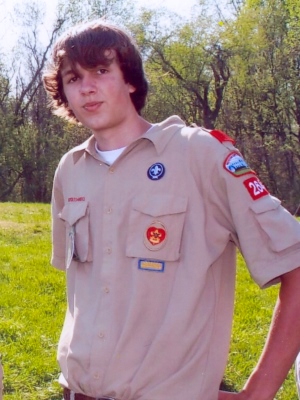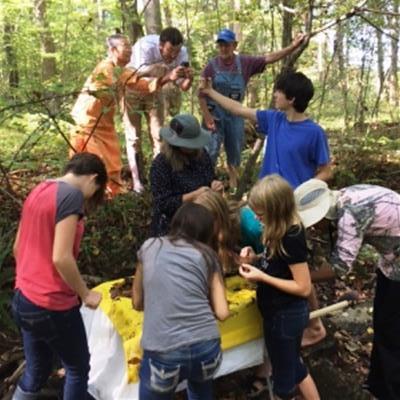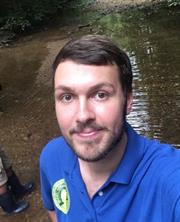Scott Maxham, IWLA Clean Water Fellow
 From a young age, I can remember feeling a connection with the outdoors – a bit surprising given that I grew up in the suburbs of Washington, DC (not exactly an area known for undisturbed natural land). I found enjoyment in the small green spaces near my home. Plus I had opportunities to experience larger pristine areas: Hiking through Philmont Scout Ranch in New Mexico with friends. Cool summer mornings spent fishing with my grandfather. Kayaking and tubing down the rivers of the mid-Atlantic.
From a young age, I can remember feeling a connection with the outdoors – a bit surprising given that I grew up in the suburbs of Washington, DC (not exactly an area known for undisturbed natural land). I found enjoyment in the small green spaces near my home. Plus I had opportunities to experience larger pristine areas: Hiking through Philmont Scout Ranch in New Mexico with friends. Cool summer mornings spent fishing with my grandfather. Kayaking and tubing down the rivers of the mid-Atlantic.
Many youth lack such nature connections today. According to research from Common Sense Media, tweens (ages 8-12) spend 6 hours each day using entertainment media – including more than 4 ½ hours of screen time – for purposes other than homework. Teens (ages 13-18) fare even worse, with 9 hours per day of entertainment media, including more than 6 ½ hours of screen time.
Getting youth to take a break from the many distracting screens and devices of today can feel like a daunting task. But there are countless benefits from outdoor learning and unstructured time outside. Fostering these connections cannot be replaced with time spent digging virtual holes. The Girl Scout Research Institute found that girls who regularly spend time outdoors seek challenges more readily and are better problem solvers than their peers. A report from The Nature Conservancy states that 90 percent of kids who spent time outside said being in nature and taking part in outdoor activities helped them relieve stress.
So how do you get kids outside and engage them to be the next generation of environmental stewards?
There is a certain disconnect when kids are lectured at rather than experiencing a topic hands-on. This is where our Creek Freaks program can help – bridging that gap and getting kids outside to learn about streams literally flowing under their feet.
 I recently taught a Creek Freaks workshop in Buckingham, Virginia. The community was concerned with potential pollution associated with a pipeline being constructed nearby. They contacted me requesting information on how they could include their children in monitoring local streams. Using our Creek Freaks curriculum, I taught the adults not only how to collect baseline water quality data but also how to engage youth in monitoring and other water-based activities.
I recently taught a Creek Freaks workshop in Buckingham, Virginia. The community was concerned with potential pollution associated with a pipeline being constructed nearby. They contacted me requesting information on how they could include their children in monitoring local streams. Using our Creek Freaks curriculum, I taught the adults not only how to collect baseline water quality data but also how to engage youth in monitoring and other water-based activities.
After the training, the parents’ minds were put at ease. We found plenty of stoneflies and other pollution-sensitive aquatic macroinvertebrates, which meant that the water was clean and safe – for now. The children returned to playing in the stream, this time with newfound skills about stream health they will take with them for the rest of their lives. I drove home with the peace of mind that young citizen scientists would be caring for this stream for decades to come.
Whether you are a youth program leader, teacher, camp counselor, Scout leader, or parent, the League offers a range of ways to get youth outdoors and involved in clean water:
- Snap a Stream Selfie. If you are struggling to get youth to turn off their phones, consider using it as a teaching tool instead. Have them take selfies with their favorite streams and look around for trash and other pollutants. Visit streamselfie.org for more details.
- Participate in a stream clean-up. It is so satisfying for youth to see the trash pile up as they clean up a local stream. All you need are trash bags, gloves, and enthusiasm! (If you are part of an Izaak Walton League chapter, you can track your results through our Chapter Accomplishments tool.)
- Get involved with Creek Freaks to monitor local streams. You don’t need fancy equipment or a science degree to monitor water quality. Visit iwla.org/creekfreaks for more information on stream monitoring with kids.

We hope to inspire the next generation of water quality monitors. Not every kid will fall in love with identifying stream bugs to check water quality, but you can help them foster a sense of caring and connection to the waters around them. These waters bring us together. We may not all be lucky enough to kayak the Everglades or hike along the Mississippi, but we can each take care of one stream.
IWLA Clean Water Fellow Scott Maxham loves clean water and helping kids connect with the outdoors.